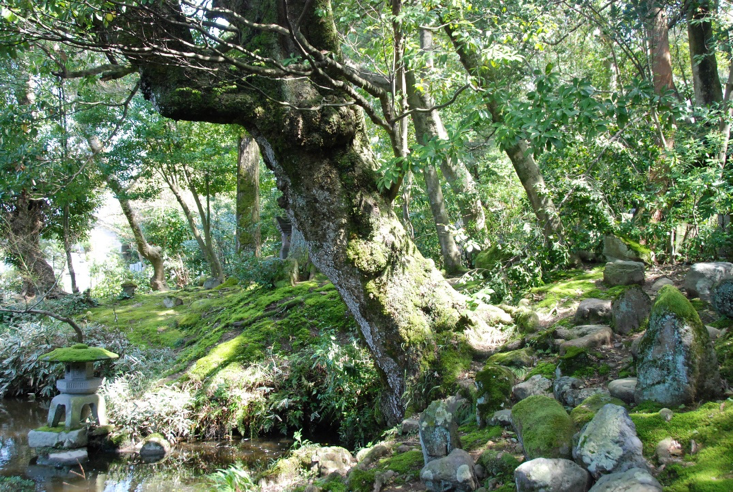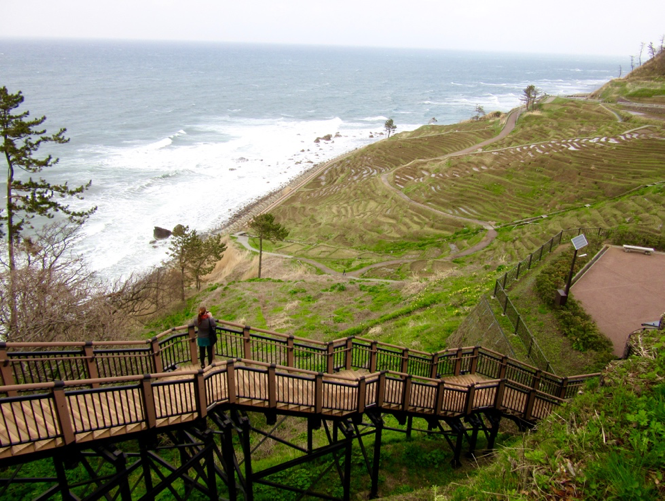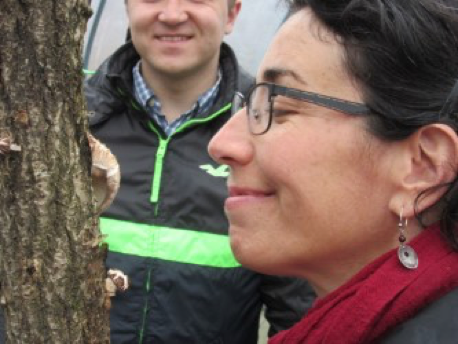Reinvigorating creative solutions to save people and planet: A walking workshop through biocultural landscapes in western Japan
Retreat to inspire progress
Cherry blossom petals carried on the spring breezes blowing through the city of Kanazawa in western Japan, where a group of researchers gathered to deepen their understanding about the role of culture in sustainable development issues and why they matter to humans and nature.
The serenity of the setting was in stark contrast to the clamorous calls to stop wasting precious time and transition to an emission-free global economy or face living on a hothouse earth. The pressures of living with the alarming reality of a bleak future coupled with the accelerating pace at which we must change, and find alternative ways to live, weigh heavily on our capacity to come up with solutions and perhaps even lead to a numbing of mind and body. In the hope of reawakening creative thought and inspiring new avenues for meeting global challenges, a small transdisciplinary group of researchers sought out spaces where creative impulses, of both mind and body, could take shape.

Vegetation and small statues meld into each other in the temple garden. Photo credit: E Andersson
Kanazawa, Japan – a natural cultural setting
The workshop took place in the Japanese city of Kanazawa for several reasons. Japanese culture is rich in tradition, diversity, innovation and beauty. Nature has inspired a wealth of creativity and that conversation between nature and humans that stretches back millennia is a source of knowledge, practices and a life imbued with meaning, symbols and rituals. The city of Kanazawa is a cultural centre (2009 UNESCO Creative City) where traditional crafts, cuisine and literature have flourished for centuries. Kanazawa is a small city and worldwide we expect to see the most growth in the number of small to medium-sized towns and cities.
As such, Kanazawa provides lessons for other regional cities trying to balance growth with maintaining culture and nature as integral parts of their identity. Urban planning of Kanazawa has tried to incorporate green infrastructure and maintain natural assets such as canals and patches of urban forest and the policy of local government has indicated substantial interest in biodiversity – the city hosted the closing of International Year of Biodiversity in 2010.
Satoyama and Satoumi – biocultural landscape and seascapes
Satoyama and satoumi (sato – rural settlement, umi-sea) are social ecological production areas in which traditions and practices have been passed down through the generations. It was raining heavily when we arrived in Higashihara, a peri-urban area made up of different ecosystems including forest, farmland, irrigation ponds, grasslands and villages.
Liang Luohui, Senior visiting scholar and consultant, Chinese Academy of Sciences and UNU-IAS said the satoyama landscape reminded him of landscapes in Yunnan, China where the dialogue between humans and nature is apparent. Land use is adapted to different parts of the mountainous areas.

Rice terraces in Senmaida, Noto Peninsula. Photo: V Mellegård.
“A typical rural landscape of Yunnan Province is composed of settlements (each house often has a home garden), farmlands (upland fields and paddy fields), orchards, plantations, secondary/primary forests, grasslands. There is often a temple or shrine in the settlement area or in the forests nearby…..The mix of different land uses in rural landscapes meet local needs for subsistence, income generation as well as spiritual wellbeing,” Luohui said.
We seemed to be the only ones there but the lack of people living there wasn’t due to the inclement weather. Over the past four or five decades there’s been a decline in populations in satoyama areas due to urbanization, industrialization and a change in construction and fuel needs which leads to under managed forests and increases in fast growing species like conifers rather than broad leaf species and, subsequently, a decrease in biodiversity in both flora and fauna.
An energetic group of women, all above 65 years of age, invited us to take shelter and put out plates of shiitake mushrooms that they cultivate on sawtooth oak and sell at a fledgling farmers market that is being supported by a not-for-profit organization (NPO) whose young manager we met. He moved to the village with his family to live a different kind of life, away from the city. He learned skills like building houses using a mixture of traditional methods and modern technology and how to produce food. Now the NPO organizes events that encourage young people to participate in learning about food production.
Francesca Farioli, Director of the Italian Association for Sustainability Science appreciated the young man’s hope in spite of adversity and his capacity “to imagine positive alternative sustainable futures and not be discouraged by the overwhelming, current systemic crisis.”
A commitment to bioculture
On the second day of the workshop, there was a public symposium to welcome the international researchers in our group and to invite their impressions about Kanazawa as well as to exchange ideas and expertise about harnessing the benefits of biocultural assets.
Michelle Cocks, Associate Professor in the Anthropology Department at Rhodes University in South Africa compared the depth of commitment and awareness within the community and in local government in Kanazawa, with South Africa:
“In South Africa, there is rich biocultural diversity but within this space the people actually engaging in it are the only ones aware of the issues. The focus is more on economics and politics and development. These are important but we are so much more than that.”
She described the feeling prevalent in many urban communities of not belonging – a legacy of the Apartheid system whereby much of the workforce migrated from their rural homes into the city, solely to earn money. Their identity, knowledge and attachment to the places they call home remains strong. Despite the central role of local identity, the national education system still focuses on conventional subjects like mathematics and doesn’t incorporate a more holistic approach that values local practices and diverse cultural identities.
Heather McMillen, Urban and Community Forester, State of Hawai’i Division of Forestry and Wildlife pointed out her interest in initiatives aimed at using vacant lots in cities as open, unstructured spaces that give people the chance to co-create. Where food production is possible, she suggested useful examples from Fiji where projects linking agro-bio-cultural diversity connect diet with culture and sense of place. Internship programmes for students to work on farms is a way to learn about business, ecology and marketing and are aimed at encouraging more young farmers to the sector. Another programme trains people to grow food locally and become interested in farming as an active form of agency in shaping the local market.
Maria Tengö, a researcher at the Stockholm Resilience Centre, drew parallels between Kanazawa and her work in Madagascar where cultural taboos have protected patches of forest that have been crucial in preserving ecosystems that are increasingly under pressure from habitat loss and environmental degradation.
“There is a strong emphasis that you do need people to take care of nature. When you take people out of landscapes, there are consequences. Of course, urbanisation has its impacts – there are fewer opportunities to enjoy nature. But this also reveals the importance of partnerships and collaborations – researchers need to partner with others and learn from the past to be able to move into the future to address the challenges.”
In recent years, Maria’s work with indigenous natural resource managers has focused on the systems of knowledge and practices that they draw on to maintain thriving social ecological niches.
“We have a lot to learn about indigenous and local knowledge – for example, about viewing a system in a more holistic way and understanding the importance of biocultural connections to wellbeing and, the process of learning itself.”

Logwood production and cultivation of shiitake mushrooms on sawtooth oak is a type of agroforestry. Villagers, most of whom are over 65 years of age, sell the shiitake mushrooms at a farmers market. Photo: V Mellegård.
What do we lose if we lose human-nature connections?
Over half of the world’s population now lives in towns or cities. At the same time, there’s an ongoing decline in biodiversity, the rich variety of habitats that support a vast network of living species and biophysical forces that together create and maintain the conditions for human life to exist, in all of its cultural diversity. Researchers studying the causes of these massive, global shifts suggest that the increase in urbanisation and the reduction in biocultural diversity are linked. As more and more people live in built environments, at a distance from landscapes co-created by humans and nature, there is a reduced awareness of the impacts of changing human lifestyles on the very natural resources that are used to fuel them. Perhaps, the adage “out of sight, out of mind” applies here too – the less contact humans have with nature, the more our interest diminishes.
Bioculture, the interplay between human culture – food, art, craft, spiritual connection, rituals – and the places and environments in which we live, are on display in every corner of the world and at every stage of human history. Biocultural diversity “the myriad ways in which humans have interacted with their natural surroundings” is enshrined by UNESCO in the same way as tangible forms of cultural heritage such as noteworthy architecture or place of extraordinary natural beauty.
Biocultural landscapes are a source of knowledge and practices about human-nature connections and might help us to identify changes in sense of place, extinction of experience, identity and social conflicts – some of the social challenges that urbanisation and migration of peoples around the world give rise to. Understanding the links and relationships between humans and nature could be significant for finding pathways for resolution in situations where people become disconnected from the places where they used to belong, or when they are forced to move, migrate or flee. Attending to the biocultural dimensions of social developments from the local right up to the global means including aspects such as diverse ways of living, shared values and a dynamic relationship between culture, the natural environment and, history. Both the differences and synergies in fractured societies might well become the source of meaning and healing.
Steffen, W., Rockström, J., Richardson, K., Lenton, T.M., Folke, C., Liverman, D., Summerhayes, C.P., Barnosky, A.D, Cornell, S.E., Crucifix, M., Donges, J.F., Fetzer, I., Lade, S.J., Scheffer, M., Winkelmann, R., and Schellnhuber, H.J. (2018) Trajectories of the Earth System in the Anthropocene. Proceedings of the National Academy of Sciences (USA), DOI: 10.1073/pnas.1810141115
M. Cocks, S. Vetter & K. F. Wiersum (2018) From universal to local: perspectives on cultural landscape heritage in South Africa, International Journal of Heritage Studies, 24:1, 35-52, DOI: 10.1080/13527258.2017.1362573
DATE
October 23, 2018AUTHOR
Viveca MellegårdSHARE WITH YOUR NETWORK
RELATED POSTS
Spotlight on LMICs – Getting Up To Speed on the Pacific Islands: A Plan for Resilience
Spotlight on LMICs – Tired of Breathing in Pollutants? Time for Better Fuel Economy and Vehicle Standards
Future Earth Taipei Holds 2024 Annual Symposium